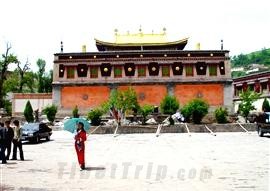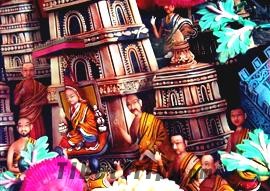 Ta'er Monastery is situated on Lotus Mountain which lies south of Lushaer Town in Qinghai's Huangzhong County, about 25 km. (15.5 mi.) away from Xining . It is one of Tibetan Buddhism 's six largest Gelugpa (Yellow Sect) monasteries, (the others being Lhasa's Ganden, Sera and Grepung , Shigatse' s Tashilhunpo, and Labrang in Gannan Tibetan Autonomous Prefecture).It also marks the birth place of Tsong Khapa, the founder of Gelugpa. The monastery is not only one of the most popular places to visit in Qinghai but is also recognised as a cultural relic site under state-level protection.
Ta'er Monastery is situated on Lotus Mountain which lies south of Lushaer Town in Qinghai's Huangzhong County, about 25 km. (15.5 mi.) away from Xining . It is one of Tibetan Buddhism 's six largest Gelugpa (Yellow Sect) monasteries, (the others being Lhasa's Ganden, Sera and Grepung , Shigatse' s Tashilhunpo, and Labrang in Gannan Tibetan Autonomous Prefecture).It also marks the birth place of Tsong Khapa, the founder of Gelugpa. The monastery is not only one of the most popular places to visit in Qinghai but is also recognised as a cultural relic site under state-level protection.Legend has it, after Tsong Khapa was born, a banyan tree grew on the spot where his mother's blood was spilt, and that the tree's ten thousand leaves all started to bear images of the Maitreya Buddha. In 1379, during the Ming Dynasty (1368 - 1644), his mother and fellow believers acted on a promise to build a stupa around the tree, and then decorated it with a picture of the Buddha sent to them by Tsong Khapa. It remains the main worshipping stupa in the Ta'er Monastery even today.
The temple was first built in 1560 but has been renovated many times over the years. It contains numerous halls, shrines, stupas and rooms of residence, all constructed in the various Han and Tibetan styles. The temple is most well-known for its embossed-style embroidery, {{murals|/arts-culture/mural.htm}} and butter sculptures. These are commonly referred to as the 'Three Bests'- butter sculpture of which being the most well-known. Such sculptures are made grand in scale and are rich in detail. They are engraved with various designs, including: landscapes; buildings; figures; animals; plants; and depictions of historical and mythical stories. On 15th January each large amounts of people visit the monastery to take part in a lantern display which is held among the various butter sculptures.
 The monastery also holds several religious ceremonies throughout the year which attract many pilgrims and visitors alike: on 15th April and 6th June a large embroidered picture of the Buddha is unveiled on Lotus Mountain, towards the east side of the temple; on 8th June a colorful sedan, mounted by a golden statue of Maitreya Buddha, is paraded around the building; and on 22nd September the temple opens all its halls to reveal its numerous treasures. During these ceremonies, a religious dance known as the Changmo (Sorcerer's Dance) is often performed.
The monastery also holds several religious ceremonies throughout the year which attract many pilgrims and visitors alike: on 15th April and 6th June a large embroidered picture of the Buddha is unveiled on Lotus Mountain, towards the east side of the temple; on 8th June a colorful sedan, mounted by a golden statue of Maitreya Buddha, is paraded around the building; and on 22nd September the temple opens all its halls to reveal its numerous treasures. During these ceremonies, a religious dance known as the Changmo (Sorcerer's Dance) is often performed.Other festivals include the Butter Lamp Festival held on 25th October (the day Tsong Khapa is believed to have died) and a prayer festival held during the Lunar New Year.
![]() Travel Tips
Travel Tips
It is possible to catch a bus to the Ta'er Monasery from the Ximen Coach Station (neighboring the Xining Gymnasium in the west of the city). Buses can be caught from the Huangzhong Coach Station for the return journey.
For those wishing to stay in the area around the temple, the Pilgrim Hostel and Ta'er Monastery Hostel offer reasonable accommodation.
|
Admission Fee
|
CNY 80
|
|
Opening Time
|
08:00 – 17:00
|
![]() Back to Map of the Tibet Railway Scenery
Back to Map of the Tibet Railway Scenery








